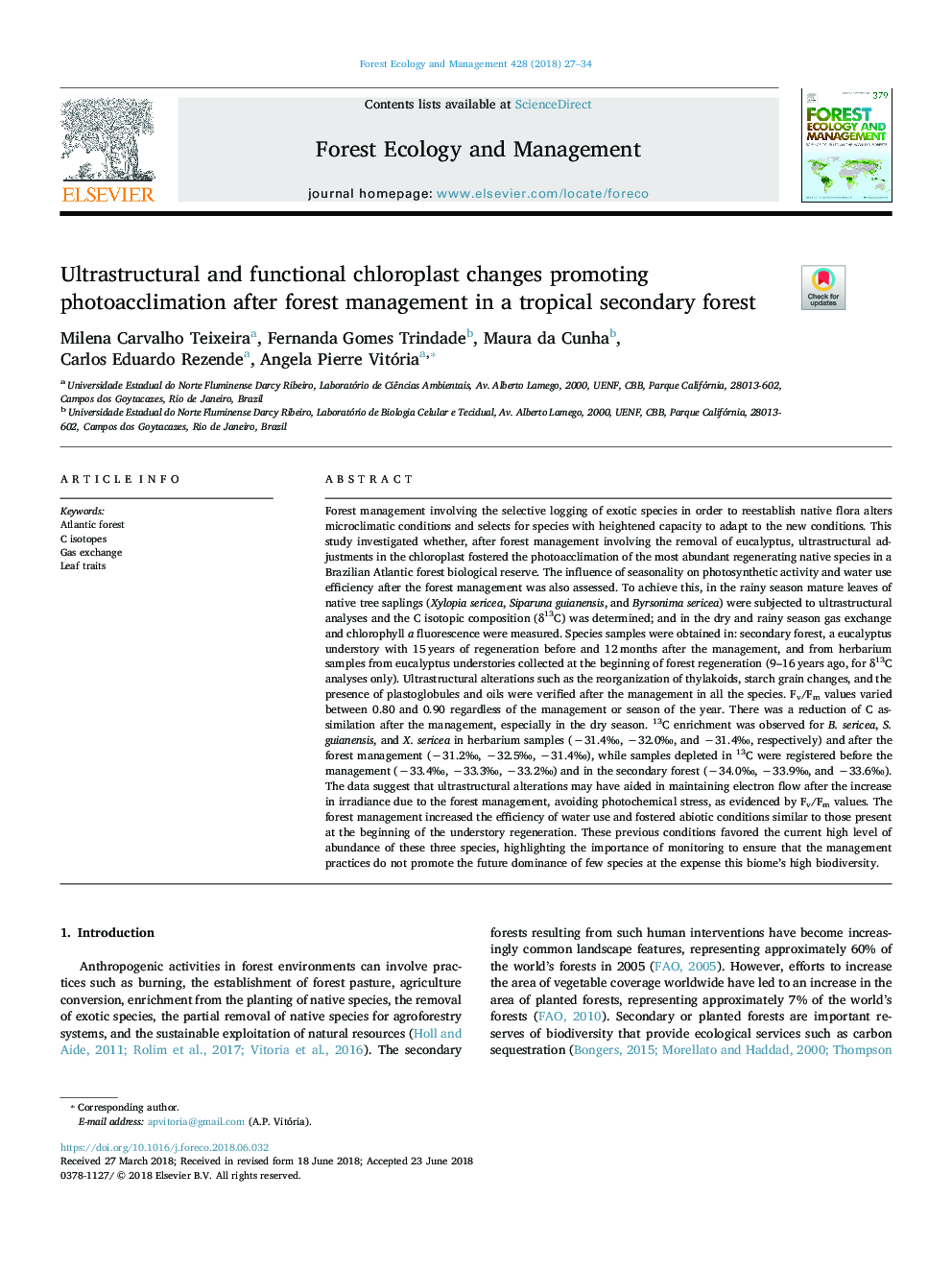| کد مقاله | کد نشریه | سال انتشار | مقاله انگلیسی | نسخه تمام متن |
|---|---|---|---|---|
| 6541475 | 1421332 | 2018 | 8 صفحه PDF | دانلود رایگان |
عنوان انگلیسی مقاله ISI
Ultrastructural and functional chloroplast changes promoting photoacclimation after forest management in a tropical secondary forest
ترجمه فارسی عنوان
تغییرات کلرپولست فوقالعاده و کاربردی، ترویج عکسبرداری پس از مدیریت جنگل در جنگل ثانوی گرمسیری است
دانلود مقاله + سفارش ترجمه
دانلود مقاله ISI انگلیسی
رایگان برای ایرانیان
کلمات کلیدی
موضوعات مرتبط
علوم زیستی و بیوفناوری
علوم کشاورزی و بیولوژیک
بوم شناسی، تکامل، رفتار و سامانه شناسی
چکیده انگلیسی
Forest management involving the selective logging of exotic species in order to reestablish native flora alters microclimatic conditions and selects for species with heightened capacity to adapt to the new conditions. This study investigated whether, after forest management involving the removal of eucalyptus, ultrastructural adjustments in the chloroplast fostered the photoacclimation of the most abundant regenerating native species in a Brazilian Atlantic forest biological reserve. The influence of seasonality on photosynthetic activity and water use efficiency after the forest management was also assessed. To achieve this, in the rainy season mature leaves of native tree saplings (Xylopia sericea, Siparuna guianensis, and Byrsonima sericea) were subjected to ultrastructural analyses and the C isotopic composition (δ13C) was determined; and in the dry and rainy season gas exchange and chlorophyll a fluorescence were measured. Species samples were obtained in: secondary forest, a eucalyptus understory with 15â¯years of regeneration before and 12â¯months after the management, and from herbarium samples from eucalyptus understories collected at the beginning of forest regeneration (9-16â¯years ago, for δ13C analyses only). Ultrastructural alterations such as the reorganization of thylakoids, starch grain changes, and the presence of plastoglobules and oils were verified after the management in all the species. Fv/Fm values varied between 0.80 and 0.90 regardless of the management or season of the year. There was a reduction of C assimilation after the management, especially in the dry season. 13C enrichment was observed for B. sericea, S. guianensis, and X. sericea in herbarium samples (â31.4â°, â32.0â°, and â31.4â°, respectively) and after the forest management (â31.2â°, â32.5â°, â31.4â°), while samples depleted in 13C were registered before the management (â33.4â°, â33.3â°, â33.2â°) and in the secondary forest (â34.0â°, â33.9â°, and â33.6â°). The data suggest that ultrastructural alterations may have aided in maintaining electron flow after the increase in irradiance due to the forest management, avoiding photochemical stress, as evidenced by Fv/Fm values. The forest management increased the efficiency of water use and fostered abiotic conditions similar to those present at the beginning of the understory regeneration. These previous conditions favored the current high level of abundance of these three species, highlighting the importance of monitoring to ensure that the management practices do not promote the future dominance of few species at the expense this biome's high biodiversity.
ناشر
Database: Elsevier - ScienceDirect (ساینس دایرکت)
Journal: Forest Ecology and Management - Volume 428, 15 November 2018, Pages 27-34
Journal: Forest Ecology and Management - Volume 428, 15 November 2018, Pages 27-34
نویسندگان
Milena Carvalho Teixeira, Fernanda Gomes Trindade, Maura da Cunha, Carlos Eduardo Rezende, Angela Pierre Vitória,
